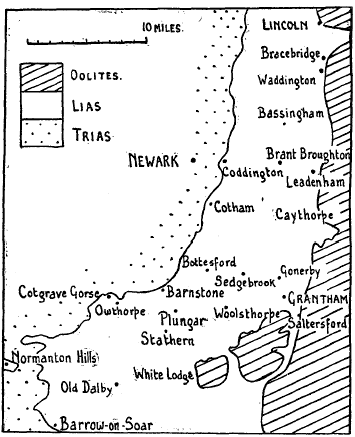Article contents
III.—The Lias of South Lincolnshire
Published online by Cambridge University Press: 01 May 2009
Extract
The area to be described is that part of the Lias outcrop extending from Lincoln southwards to Barrow-on-Soar and Grantham, and includes south-west Lincolnshire and small portions of northeast Leicestershire and east Nottinghamshire (see Map, Fig. 1).

The rocks of this district were mapped by the Geological Survey, and an account of some of them was published in 1885 and 1888; the south-western part of the area has been resurveyed and described in more recent memoirs. A summary of the geology of the area was prepared in 1910 by A. J. Jukes-Browne, but except for these publications the literature is scattered and consists mainly of short papers; details of these are given where they are referred to.
- Type
- Original Articles
- Information
- Copyright
- Copyright © Cambridge University Press 1918
References
page 64 note 1 The Geology of South-West Lincolnshire (Mem. Geol. Surv.), 1885Google Scholar.
page 64 note 2 Country around Lincoln (Mem. Geol. Surv.), 1888Google Scholar.
page 65 note 1 Lincolnshire., Jubilee Vol., Geol. Assoc., 1910Google Scholar.
page 65 note 2 Trueman, A. E., “Lias Brickyards in South-West Lincolnshire.”: Trans. Lincs Nat. Union, 1917Google Scholar.
page 65 note 3 Lang, , “Geology of Charmouth Cliffs., etc.”: Proc. Geol. Assoc., 1914, p. 307Google Scholar.
page 66 note 1 Vaughan, A., “Lower Beds of the Lower Lias of Sedbury Cliff.”: Q.J.G.S., vol. lix, p. 396, 1903CrossRefGoogle Scholar.
page 66 note 2 Trueman, A. E., “Fauna of the Hydraulic Limestones.” Geol. Mag., Dec. VI, Vol. II, p. 150, 1915CrossRefGoogle Scholar.
page 67 note 1 Wright, T., “Lower Lias and Avicula contorta zone.”: Q.J.G.S., vol. xvi, p. 374, 1860CrossRefGoogle Scholar.
page 67 note 2 See, for example, Woodward, H. B., Lias of England and Wales (Mem. Geol. Surv.), 1893, pp. 137, 141, 145Google Scholar.
page 67 note 3 Richardson, L., Geology of Cheltenham, 1904, p. 38Google Scholar.
page 67 note 4 Buckman, S. S., Yorkshire Type Ammonites, vol. i, p. xvi, 1910Google Scholar.
page 67 note 5 Wilson, E., Geology of South-West Lincolnshire (Mem. Geol. Surv.), 1885, p. 27Google Scholar.
page 67 note 6 Woodward, H. B., Lias of England and Wales (Mem. Geol. Surv.), 1893, p. 169Google Scholar.
page 67 note 6 In Geology o Country near Leicester (Mem. Geol. Surv.), 1903, pp. 22–23Google Scholar.
page 68 note 1 The forms known as Schlotheimia catenata, d'Orb., should be referred to several species of the genus Waehneroceras. See Table of FossilsGoogle Scholar.
page 68 note 2 Wright, T., “Monographs of Lias Ammonites.”: Palæont. Soc., pl. xix, figs. 5–7Google Scholar.
page 68 note 3 Hyatt, A., “Genesis of the Arietid.æ”: Smiths. Contrib. Knowl., 1889, TablesGoogle Scholar.
page 70 note 1 Trueman, A. E., op. cit., 1915, p. 152Google Scholar.
page 70 note 2 Geology of Melton Mowbray (Mem. Geol. Surv.), 1909, p. 19Google Scholar.
page 70 note 3 Geology of South. West Lincolnshire (Mem. Geol. Surv.), 1885, p. 21Google Scholar.
page 71 note 1 Water-supply of Lincolnshire (Mem. Geol. Surv.), 1904, pp. 63, 101Google Scholar.
page 71 note 2 By Burton, F. M.; see Geology of Lincoln (Mem. Geol. Surv.), 1888, p. 19Google Scholar.
page 72 note 1 Cross, J. E., “Geology of North-West Lincolnshire.”: Q.J.G.S., vol. xxxi, p. 123, 1875Google Scholar.
page 72 note 2 Geology of South-West Lincolnshire (Mem. Geol. Surv.), 1885, p. 30Google Scholar.
page 72 note 3 Gibson, W., Geology of Melton Mowbray., etc. (Mem. Geol. Surv.), 1909, p. 33Google Scholar.
- 15
- Cited by


